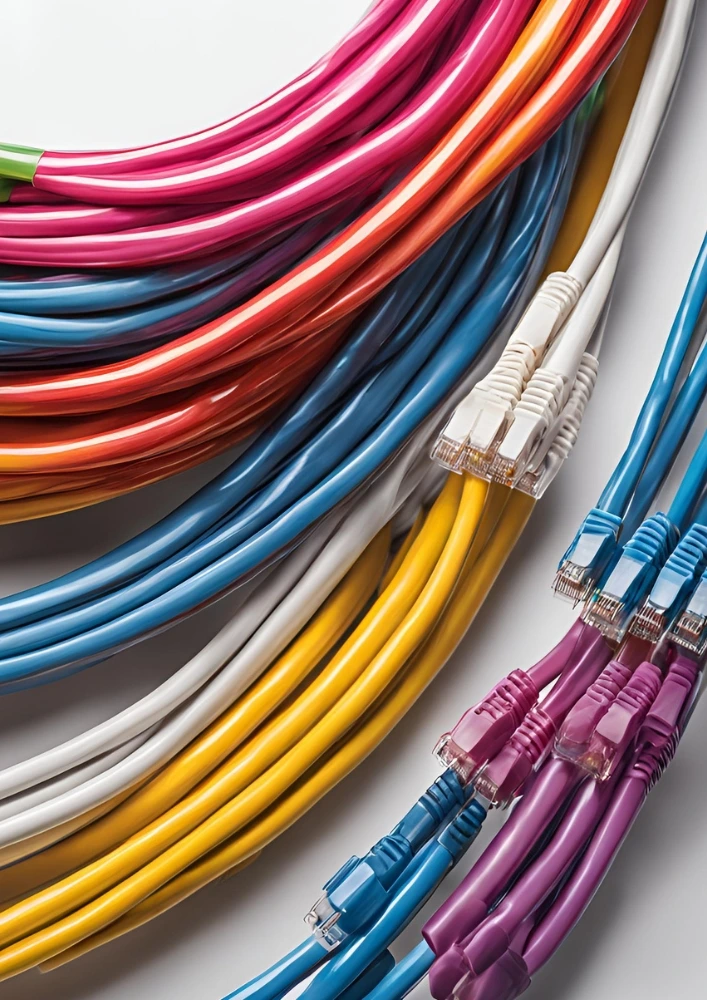Jan 20 2025
/
The Ultimate Guide to Cable Management for Ethernet and Network Cables

Messy cables can turn even the most sophisticated network setup into a tangled nightmare. Whether you’re an IT professional ensuring the efficiency of a server room, a network engineer troubleshooting connection issues, or a tech enthusiast building the ultimate smart home system, proper cable management is critical for performance, safety, and aesthetics.
This guide dives into the best practices, tools, and methods for managing Ethernet and network cables effectively. By the end of this blog, you’ll know how to take control of your cables, improve the efficiency of your network, and leave chaos behind.
Why Cable Management Matters
You may shrug off the state of your Ethernet or network cables, thinking, “They’re just cables.” But poor cable management can have real consequences.
1. Improves Efficiency
Tangled cables make day-to-day tasks harder, especially when you need to replace or troubleshoot specific wires. Organized cables streamline maintenance and repairs, saving you valuable time.
2. Reduces Downtime
When cables are unlabeled or jumbled, the chances of unplugging the wrong line or creating accidental damage increase. Organized layouts reduce those risks, ensuring smoother network performance.
3. Enhances Network Performance
Cable clutter can impede airflow in networking equipment, causing devices to overheat. Proper cable management helps maintain optimal performance by promoting adequate ventilation.
4. Looks Professional
Whether it’s a small contained setup at home or a massive enterprise network, clean cable management speaks volumes about your attention to detail and professionalism.
Now that we’ve established its importance, let’s move on to the techniques and tools that will keep your cables under control.
Key Techniques for Effective Cable Management
Managing Ethernet and network cables is more technical than it may seem. Here are the strategies to get you started.
1. Plan Your Layout Before You Begin
Before plugging in a single cable, plan your setup. Start by mapping out all required connections and equipment placement.
- Diagram Your Setup: Sketch a network diagram showing all devices and their interconnections.
- Route Strategically: Use the shortest cables necessary while avoiding paths that intersect power cables to minimize interference.
2. Label Every Cable
Imagine troubleshooting a server room with 200 unlabeled Ethernet cables. It’s a logistical nightmare. Proper labeling eliminates confusion and speeds up repairs.
- Use cable tags, tape with written identifiers, or printed heat-shrink tubing.
- Clearly indicate both ends of each cable for easy identification, such as marking one side “Router” and the other “Switch.”
3. Use Cable Management Tools
Several tools are designed to organize and secure Ethernet and network cables. Below are the essentials you’ll need:
- Cable Trays or Raceways: Ideal for long runs to keep bundles clean and off the ground.
- Cable Clips and Ties: Keep loose cables together tightly. Opt for reusable Velcro ties instead of zip ties for flexibility.
- Cable Sleeves: For a sleek, bundled look for cables running to a wall outlet or server rack.
- Patch Panels: Organize your Ethernet cables centrally, making it easier to troubleshoot and replace them.
4. Implement Structured Cabling
Structured cabling is the gold standard for large-scale setups like data centers and large office networks. It organizes cables into standardized, consistent bundles.
Benefits include better reliability, scalability for future growth, and reduced operational costs.
5. Separate Cable Types
Avoid mixing your Ethernet cables with power cables or audiovisual cables. This separation minimizes electrical interference and keeps the airflow for heat-sensitive cables uninterrupted.
- Group cables by function for clarity (e.g., “Data” cables, “Power” cables, etc.).
- Use color-coded cables for immediate visual identification.
6. Maintain Proper Bend Radius
Incorrectly bending Ethernet cables can cause signal degradation. Ensure cables maintain their natural curvature and don’t bend too sharply.
7. Clean and Maintain Regularly
Cable management isn’t “set it and forget it.” Dust, cable wear, or added hardware change setups over time. Periodically inspect your system and address any emerging mess.
- Vacuum or carefully dust cable trays and areas beneath setups.
- Replace frayed or damaged cables immediately.
Common Tools for Network Cable Management
If you’re serious about cable organizing, these must-have products can simplify the process significantly.
- Velcro Cable Ties – Adjustable and reusable ties for bundling cables.
- Cable Raceways – Enclosed channels that route cables along walls.
- Patch Cords of Various Lengths – Keep cables manageable by selecting appropriate lengths.
- Rack Mount Panels – Perfect for data centers and server rooms to centralize connections.
- Label Printers – High-quality labels for a polished and professional setup.
Frequently Asked Questions
Q1. Why should I avoid mixing Ethernet and power cables?
Mixing Ethernet cables with power cables can cause electromagnetic interference, leading to reduced network performance. It’s best to route them separately or use shielded cables to minimize interference.
Q2. How does cable management affect network performance?
Proper cable management ensures cables don’t obstruct airflow in network equipment, preventing overheating. Well-organized cables also reduce the chances of physical damage.
Q3. What's the best way to manage cables over long distances?
Use cable trays, raceways, or conduit for long-distance cable runs. They provide a neat path, protect wires from damage, and make future upgrades easier.
Q4. Are patch panels worth investing in?
Yes. Patch panels simplify cable organization and make troubleshooting significantly faster, especially in larger systems.
Q5. How do I keep cables hidden in home setups?
For home setups, use cable sleeves, adhesive clips, or raceways to keep cables secured and out of sight. Furniture placement can also help conceal them effectively.
